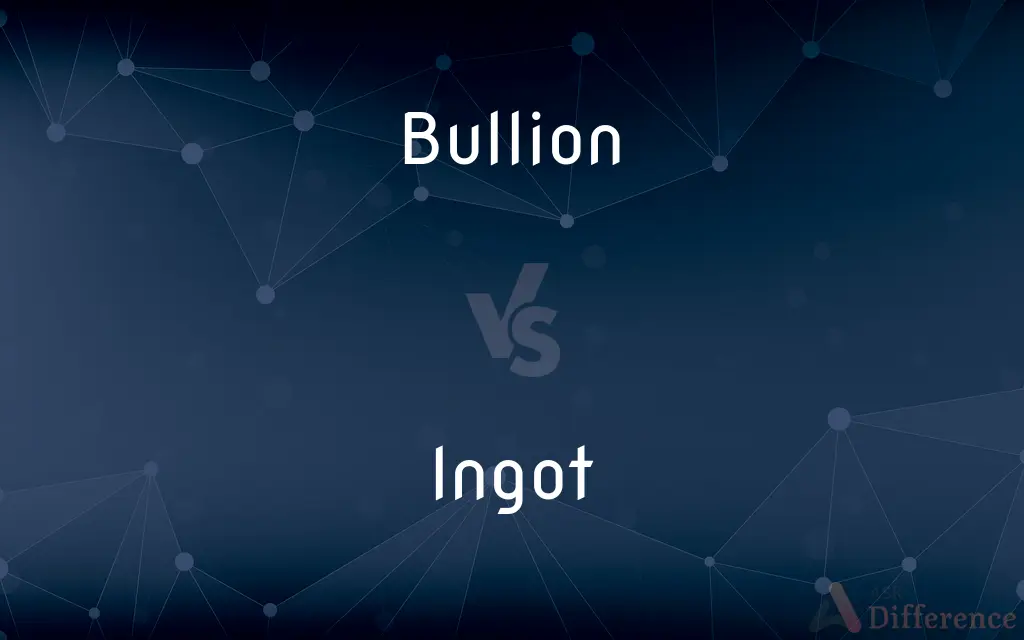Bullion vs. Ingot — What's the Difference?
By Tayyaba Rehman & Fiza Rafique — Updated on May 7, 2024
Bullion refers to gold, silver, or other precious metals in bulk form, measured by weight and value, while an ingot is a shaped bar or block of metal typically created for easier handling, storage, and processing.

Difference Between Bullion and Ingot
Table of Contents
ADVERTISEMENT
Key Differences
Bullion is the term for precious metals, like gold and silver, in their rawest, high-purity form. They are often traded in markets based on their weight and purity, whereas ingots are specific molds of metal, usually rectangular, facilitating ease of transport and storage.
Bullion includes gold or silver in various forms, like coins or bars, to ensure its weight and quality. On the other hand, ingots generally refer to bars or blocks that can be made from various metals, including base metals and precious metals.
Bullion is frequently used in international trade and investing as it's recognized by weight and fineness. In contrast, ingots can vary in quality and composition depending on their intended industrial or commercial purpose.
Bullion is mostly sought after by investors looking for secure assets, often in coin or bar form. Meanwhile, ingots are used by manufacturers and the industry as raw material for further processing and manufacturing.
Comparison Chart
Definition
Precious metals in bulk form
Bar/block of metal
ADVERTISEMENT
Metals Included
Gold, silver
Precious and base metals
Purpose
Investment, trade
Manufacturing, processing
Form
Bars, coins
Typically rectangular bar/block
Quality
Highly standardized for purity and weight
Varies according to composition
Compare with Definitions
Bullion
Asset form for wealth preservation.
During economic downturns, many people buy bullion to protect their savings.
Ingot
Manufactured to produce different shapes and sizes.
The mint produced smaller ingots for collectors.
Bullion
High-purity gold or silver in bulk.
The investor stored gold bullion in a secure vault.
Ingot
A metal bar typically shaped for transportation.
The factory melted ingots for further manufacturing.
Bullion
Recognized unit of precious metals used for trading.
Silver bullion prices fluctuate based on market demand.
Ingot
Rectangular metal mold for ease of storage.
Aluminum ingots are stacked neatly in the warehouse.
Bullion
Bulk metal assessed for weight and purity.
The bank stored significant reserves of bullion.
Ingot
Often the initial form post-smelting.
Copper ingots are refined into electrical wires.
Bullion
A standard measure for international commerce.
Many countries hold bullion as part of their foreign reserves.
Ingot
Made from various metals like steel, aluminum, or precious metals.
Gold ingots are processed with high precision.
Bullion
Bullion is non-ferrous metal that has been refined to a high standard of elemental purity. The term is ordinarily applied to bulk metal used in the production of coins and especially to precious metals such as gold and silver.
Ingot
An ingot is a piece of relatively pure material, usually metal, that is cast into a shape suitable for further processing. In steelmaking, it is the first step among semi-finished casting products.
Bullion
Gold or silver considered with respect to quantity rather than value.
Ingot
A mass of metal, such as a bar or block, that is cast in a standard shape for convenient storage or shipment.
Bullion
Gold or silver in the form of bars, ingots, or plates.
Ingot
A casting mold for metal.
Bullion
A heavy lace trimming made of twisted gold or silver threads.
Ingot
A solid block of more or less pure metal, often but not necessarily bricklike in shape and trapezoidal in cross-section, the result of pouring out and cooling molten metal, often immediately after smelting from raw ore or alloying from constituents.
Bullion
A bulk quantity of precious metal, usually gold or silver, assessed by weight and typically cast as ingots.
Ingot
(transitive) To form (scraps of metal) into ingots.
Bullion
(obsolete) Base or uncurrent coin.
Ingot
That in which metal is cast; a mold.
And from the fire he took up his matterAnd in the ingot put it with merry cheer.
Bullion
(obsolete) Showy metallic ornament, as of gold, silver, or copper, on bridles, saddles, etc.
Ingot
A bar or wedge of steel, gold, or other malleable metal, cast in a mold; a mass of unwrought cast metal.
Wrought ingots from Besoara's mine.
Bullion
(obsolete) A heavy twisted fringe, made of fine gold or silver wire and used for epaulets; also, any heavy twisted fringe whose cords are prominent.
Ingot
A block of metal that is cast in a particular shape for convenient handling
Bullion
Uncoined gold or silver in the mass.
Bullion
Base or uncurrent coin.
And those which eld's strict doom did disallow,And damm for bullion, go for current now.
Bullion
Showy metallic ornament, as of gold, silver, or copper, on bridles, saddles, etc.
The clasps and bullions were worth a thousand pound.
Bullion
Heavy twisted fringe, made of fine gold or silver wire and used for epaulets; also, any heavy twisted fringe whose cords are prominent.
Bullion
A mass of precious metal
Bullion
Gold or silver in bars or ingots
Common Curiosities
Can bullion be considered an ingot?
Yes, bullion can be in ingot form, especially gold or silver bars used for investment.
Why is bullion often stored in bars or coins?
Bars or coins simplify valuation and recognition, which is essential for trading and investing.
Are all ingots made of precious metals?
No, ingots can be made of both precious and base metals.
Can ingots be melted down for different uses?
Yes, ingots are often melted to produce specific components.
What makes bullion unique compared to ingots?
Bullion is unique for its recognized weight and high purity, whereas ingots vary in shape and composition.
Why are ingots useful in manufacturing?
They provide a manageable form of metal that's easy to transport and refine.
How do bullion prices fluctuate?
Bullion prices change based on supply, demand, and economic factors.
What materials are typically used for bullion?
Bullion commonly consists of gold or silver due to their investment value.
Which is better for investment: bullion or ingots?
Bullion is generally better for investment due to its purity and standardized valuation.
Are ingots standardized for trade like bullion?
Not necessarily. Ingots are often customized based on industrial needs.
Do bullion coins qualify as ingots?
No, bullion coins are not ingots, as they're minted and used primarily for currency or investment.
What industries frequently use ingots?
Manufacturing and construction industries often utilize ingots as raw materials.
How does bullion aid in international trade?
Bullion offers a universally recognized value standard for settling international transactions.
Is it easier to find a buyer for bullion or ingots?
Bullion typically has a more liquid market due to its standardized nature.
What distinguishes an ingot from a casting?
Ingots are pre-shaped metal blocks, while castings are molten metals poured into molds to take specific shapes.
Share Your Discovery

Previous Comparison
Sited vs. Seated
Next Comparison
Airport vs. JetportAuthor Spotlight
Written by
Tayyaba RehmanTayyaba Rehman is a distinguished writer, currently serving as a primary contributor to askdifference.com. As a researcher in semantics and etymology, Tayyaba's passion for the complexity of languages and their distinctions has found a perfect home on the platform. Tayyaba delves into the intricacies of language, distinguishing between commonly confused words and phrases, thereby providing clarity for readers worldwide.
Co-written by
Fiza RafiqueFiza Rafique is a skilled content writer at AskDifference.com, where she meticulously refines and enhances written pieces. Drawing from her vast editorial expertise, Fiza ensures clarity, accuracy, and precision in every article. Passionate about language, she continually seeks to elevate the quality of content for readers worldwide.
















































